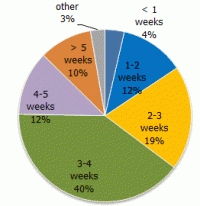You can be a great coach, but be less effective because your conversations are too long or too short or not frequent enough. This applies to anyone helping people grow: coaches, managers, parents, and ministers. What length, frequency, and delivery methods produce the most effective coaching conversations? Several studies point us to answers.

A study by Coaching Research Institute LLP polled clients about the behaviors and structures their professional coaches used and the resulting effects on clients. Significantly, those surveyed were clients not coaches, as in most coaching studies. Ninety-three professional coaches from 14 countries did the coaching.
The survey measured 22 results clients received from coaching. Things like:
- I achieved goals set at the start of the coaching engagement.
- I am satisfied with the coaching engagement.
- My direction and vision have become clearer.
It also measured 18 behaviors of the coaches. Things like, the coach “listened until I finished speaking,” “I felt safe to share,” and the coach “did not impose his/her ideas.”
Here’s what the survey found and how you might be able to increase the effectiveness of your coaching conversations by adjusting the structure.
1. The Length Of Coaching Conversations
How long are your coaching conversations? You might be surprised the learn that 50% of coaching conversations were between 30-39 minutes. The second most popular length for a coaching session was between 60-69 minutes.
How did shorter conversations stack up against longer ones?
It turns out that there’s not much benefit to a longer versus a shorter time. A separate UK study found that awareness can actually decrease with longer coaching conversations.
Rather than coaching by the hour, how about operating from a results perspective and stopping when the coachee gains new insights that enabling her to move forward?
As with many tasks, having a deadline helps us become more focused and productive. Coaching for 30 minutes, instead of an hour, may help you and your coachee to get a clearer Outcome for the conversation and sharpen your focus on achieving it.
2. The Frequency of Coaching Conversations
How often are your coaching conversations? The study revealed that 40% were coached every 3-4 weeks, followed by 19% every 2-3 weeks.
What coaching frequency correlated with the most positive results?
This time there’s a clear winner, and it’s 1-2 weeks. By far! Nearly every one of the 22 positive effects of coaching were higher when coaching conversations occurred every 1-2 weeks. The majority of the 18 ideal behaviors of the coach were also evaluated higher.
A study of pastors of new churches also demonstrated a link between greater frequency and results. That study found weekly conversations correlated with around 50% greater results than monthly meetings. An interesting side-note is that monthly coaching conversations were actually less effective than quarterly ones.
I’ve long been an advocate of coaching every 2 weeks. Many people are stuck in a once-a-month mindset, thinking they are too busy to coach more often. But it’s just not as effective. More frequent conversations and perhaps shorter conversations may promote better coaching behaviors from you, and produce better results for the coachee.
3. The Delivery Method of Coaching Conversations
How do you deliver coaching? The two main delivery methods are in-person and by telephone (or something like Skype). The study showed that one-third of coaching engagements were done in-person, two-thirds over the phone.
Which is more effective, in person or by telephone?
On this point the study focused on the coach’s behavior. Clients reported that when coaching was conducted by phone, the coach gave less directions and advice from a superior standpoint. The coach also offered more observations on things he or she noticed. During in-person coaching, the coach provided more value-added information through resources such as books and case studies.
Why the change in the coach’s ability to remain in “coach mode” over the phone versus in-person? Basically, we have to work harder and concentrate more to coach over the telephone. This heightened state may increase our coaching presence, depth of observations, and keep us so busy listening that we are less tempted to begin teaching or advising.
You and your coachee’s preferences do need to be figured in, but overall there is a correlation between structure and your coaching behaviors and coachee results. Shorter, more frequent coaching conversations produce better results.
So, what changes do you want to experiment with regarding length, frequency or delivery of coaching?
Question: What do you find most effective for coachee results? You can leave a comment by clicking here.




Very helpful, Keith! Until After I completed your coach training two years ago, I was coaching I moved my coaching appointments to every other week for 45 minutes. This turned to be a great decision. Thanks for the post.
Glad 45 minutes, every two weeks is working well for you! I love the writing you’re doing at your blog.
Thanks for this post, Keith. Length and frequency of coaching conversations is a great topic. I have had clients who made much better progress when we moved our sessions from monthly to twice monthly, but I also have experienced strong client progress for some while meeting monthly for 90 minutes per session.
There are many factors in determining what is most effective for a given client and specific goals and as we gain experience as coaches we’ll get better at discerning how best to structure our programs.
Your article prompts me to begin to enumerate those factors which have a bearing on frequency and duration.
Having said that, I find the twice monthly programs a good starting rhythm. A frank conversation with our clients after 3 or 4 meetings will also provide valuable input on the effectiveness.
Thanks for your consistent contribution to the coaching world.
Thanks for sharing your experience John. There aren’t any firm and fast rules here. I know a very effective coach who does once a month in person for 3 hours. The important thing for me is to not get stuck a rut, but to keep evaluating what pattern would be most effective for my clients.
Thanks for a provocative article! I have found the shortened sessions to be much more productive and helpful for young managers who lead busy lives, but are focused for their coaching sessions.
The definitive research guidelines helped me tremendously. I’ve been searching high-and-low for this type of research.
Question:
1. How would one (if necessary) adjust rates for online-only training? I think I know what you’re gonna reply…
2. I’m still trying to get my footing on rates for individuals, corporations and whatnot. I really appreciated the sample breakdowns in your previous post (How to Serve Your Customers By Increasing Value, And Fees) Have you other sample rate/fee structures of other successful coaches?
Thanks Keith
Rate and fee structure are hugely varied. Everyone is interested in it. But there are so many variables that each person needs to create their own. This is why I share principles more than formulas.
Great point. Thanks Keith.